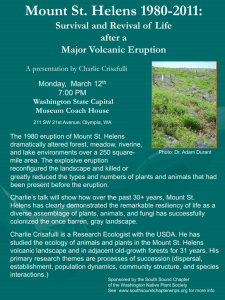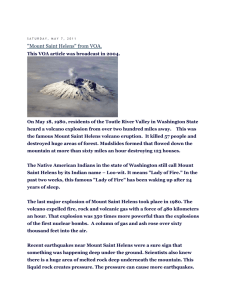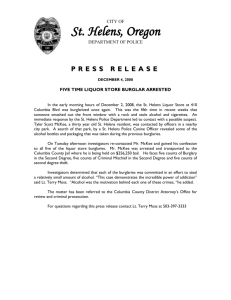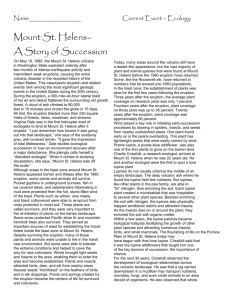PNW
advertisement
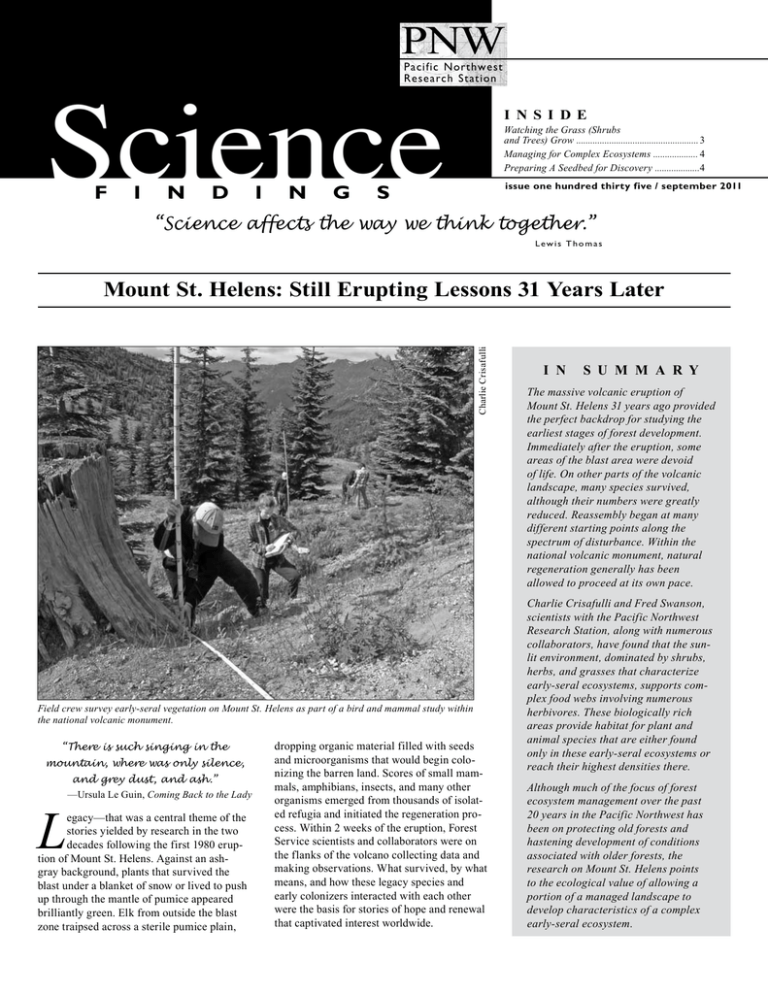
PNW Pacific Northwest Research Station I n s i d e Watching the Grass (Shrubs and Trees) Grow ....................................................3 Managing for Complex Ecosystems ...................4 Preparing A Seedbed for Discovery ...................4 F I N D I N G issue one hundred thirty five / september 2011 S “Science affects the way we think together.” Lewis Thomas Charlie Crisafulli Mount St. Helens: Still Erupting Lessons 31 Years Later Field crew survey early-seral vegetation on Mount St. Helens as part of a bird and mammal study within the national volcanic monument. “There is such singing in the mountain, where was only silence, L and grey dust, and ash.” —Ursula Le Guin, Coming Back to the Lady egacy—that was a central theme of the stories yielded by research in the two decades following the first 1980 eruption of Mount St. Helens. Against an ashgray background, plants that survived the blast under a blanket of snow or lived to push up through the mantle of pumice appeared brilliantly green. Elk from outside the blast zone traipsed across a sterile pumice plain, dropping organic material filled with seeds and microorganisms that would begin colonizing the barren land. Scores of small mammals, amphibians, insects, and many other organisms emerged from thousands of isolated refugia and initiated the regeneration process. Within 2 weeks of the eruption, Forest Service scientists and collaborators were on the flanks of the volcano collecting data and making observations. What survived, by what means, and how these legacy species and early colonizers interacted with each other were the basis for stories of hope and renewal that captivated interest worldwide. I N S U M M A R Y The massive volcanic eruption of Mount St. Helens 31 years ago provided the perfect backdrop for studying the earliest stages of forest development. Immediately after the eruption, some areas of the blast area were devoid of life. On other parts of the volcanic landscape, many species survived, although their numbers were greatly reduced. Reassembly began at many different starting points along the spectrum of disturbance. Within the national volcanic monument, natural regeneration generally has been allowed to proceed at its own pace. Charlie Crisafulli and Fred Swanson, scientists with the Pacific Northwest Research Station, along with numerous collaborators, have found that the sunlit environment, dominated by shrubs, herbs, and grasses that characterize early-seral ecosystems, supports complex food webs involving numerous herbivores. These biologically rich areas provide habitat for plant and animal species that are either found only in these early-seral ecosystems or reach their highest densities there. Although much of the focus of forest ecosystem management over the past 20 years in the Pacific Northwest has been on protecting old forests and hastening development of conditions associated with older forests, the research on Mount St. Helens points to the ecological value of allowing a portion of a managed landscape to develop characteristics of a complex early-seral ecosystem. Now the second chapter has begun. Charlie Crisafulli and Fred Swanson, scientists with the Pacific Northwest (PNW) Research Station, have spent the past 31 years studying the transformation of the post-eruption landscape in southern Washington. In that time they’ve observed, measured, and contemplated the ecological change that has unfolded in the wake of intense volcanic disturbance. Their work has helped broaden the scope of volcano research, giving form to the field of long-term volcano ecology. One theme emerging from this second chapter of research is the unique characteristics and biological richness found in the early stages of naturally developing ecosystems. • Early-seral ecosystems that have developed naturally host a variety of plant and animal species that are either found only in these open, preforest environments, or reach their highest densities there. • Mount St. Helens is a regional hotspot for early-seral ecosystems and their characteristic plant and animal species. In addition to biological richness, these patchy environments are characterized by highly fluctuating boom-and-bust population cycles and high levels of herbivory. • Although young tree plantations are commonly referred to as early-seral systems, they differ dramatically from naturally regenerating systems where shrubs, herbs, and grasses are the dominant life forms and trees play a minor role. • Large, intense disturbances such as the 1980 eruption of Mount St. Helens reset forest systems to a range of early-seral stages. At the extreme end of the disturbance spectrum, early-seral stages last for several decades, and perhaps longer. • Fire suppression and forest restoration activities have made slowly regenerating ecosystems a rarity on the west side of the Cascade Range of Oregon and Washington. This has likely influenced the distribution and abundance of species associated with complex early-seral habitats. Within the Mount St. Helens National Volcanic Monument, designated by Congress in 1982, the landscape has been left to respond on its own. In the blowdown zone—where the hurricane-force winds generated by the eruption simply blew the trees over—Pacific silver fir, mountain hemlock, big huckleberry, Charlie Crisafulli After the 1980 eruption, some areas within the blast area were salvage-logged. That land was replanted primarily with Douglas-fir and noble fir seedlings—in places it was necessary to use an auger to punch through the tephra (volcanic pumice) to place the seedling roots in the pre-eruption soil. Thirty-one years later, many of those trees growing on favorable sites are 16 inches in diameter and 50 feet tall. They are similar to other conifer plantations in the Pacific Northwest. The trees grow 8 feet apart, with simple structure and low biological diversity. Herbicides were applied to the industry plantations within the blast area to minimize competition from herbs in shrubs. A precommercial thinning and commercial harvest have since been done on some patches of private land. K E Y F I ND I N G S vine maple, and scores of other legacy species protected under snow during the eruption grow intermixed with sun-loving early colonizers such has fireweed and pearly everlasting. The resulting variety of fruiting and flowering vegetation supports rich food webs. Purpose of PNW Science Findings To provide scientific information to people who make and influence decisions about managing land. PNW Science Findings is published monthly by: Pacific Northwest Research Station USDA Forest Service P.O. Box 3890 Portland, Oregon 97208 Send new subscriptions and change of address information to: pnw_pnwpubs@fs.fed.us Rhonda Mazza, editor; rmazza@fs.fed.us Cheryl Jennings, layout; cjennings@fs.fed.us Science Findings is online at: http://www. fs.fed.us/pnw/publications/scifi.shtml To receive this publication electronically, change your delivery preference here: http://www.fs.fed.us/pnw/publications/subscription. shmtl The open, nonforest conditions support plant and animal species that are not found under forest cover. United States Department of Agriculture Forest Service 2 Charlie Crisafulli Charlie Crisafulli Although both of these images show planted forests, they differ in the amount and variety of undergrowth that they support. The left image shows a Douglas-fir plantation planted below 3,000 feet. The tree canopy has closed and the stand has almost no undergrowth. Noble fir (right image) were planted above 3,000 feet; these trees have grown more slowly than the lower elevation Douglas-fir, and shrubs, grasses, and other vegetation can be found. WATCHING THE GRASS (SHRUBS AND TREES) GROW F orests have various stages of development, each defined by dominance of different species and complexity of the forest structure. Absent disturbance, a forest stand may move though consecutive stages of development. The 1980 eruption of Mount St. Helens, however, was a major disturbance that reset the successional clock, so to speak. It created a backdrop for studying the very early stages of forest development—what scientists refer to as the early-seral ecosystem. “For the most part, ecologists haven’t had a good opportunity to study slowly developing early-seral ecosystems because the most extreme events occur relatively infrequently, and when they do, the tendency is to tinker with them in the aftermath,” explains Crisafulli. Current management practices effectively lessen the time a disturbed ecosystem spends in this early stage. Fire suppression, for example, lessens the amount of early-seral habitat that might be created in the first place. Replanting a burned area or timber harvest area with young conifer seedlings and using herbicides to reduce competing vegetation cuts short the preforest conditions. Once the saplings are big enough to form a canopy that prevents sunlight from reaching the ground, they begin shading out life that thrives in this early-seral stage. “What we’ve seen on Mount St. Helens is that early-seral ecosystems have very high levels of biodiversity,” says Crisafulli. “There’s a suite of mammals, birds, insects, and arachnids that we just don’t find in closed-canopy conditions,” he continues. “An entire segment of the regional biota is either present only in these early successional habitats or reaches its highest density in these environments.” To tell this story, one could focus on single species—charismatic ones like the horned lark or Cascade golden-mantled ground squirrel—or on obscure carabid beetles and spiders that prefer the sunlit patches that characterize an early-seral ecosystem. But Crisafulli points out that the larger story lies in the food webs that are based in these earlyseral habitats. Food-rich environments lead to primary and secondary consumers. The magenta-colored Cardwell’s penstemon, for example, is the host plant for Edith’s checkerspot butterfly, a food source for the common nighthawk. The more varieties of food a landscape offers, the more life forms it will support. Practices that systematically reduce the availability and distribution of these habitats and shorten this early stage of ecosystem development could potentially influence evolutionary processes, leading to loss of genetic diversity and perhaps even elimination of species that depend on these ecosystems, Crisafulli hypothesizes. “This is an interesting juncture in the history of thinking about forests across much of our region, where we have had a couple of decades of intense focus on old growth,” says Swanson. “Now, fire suppression and intensive forest plantation management on private land, and the near absence of regeneration harvest on federal forest land, may limit the extent of highly diverse, early-seral forest ecosystems across some parts of this region,” he says. Small mammal communities differ substantially in composition and abundance between undisturbed reference forests and complex early-seral habitats. 3 MANAGING FOR COMPLEX ECOSYSTEMS T Charlie Crisafulli he scientists see natural ecological succession, even if it is very slow, as the foundation for sustaining the many native plant and animal communities and associated biotic interactions, such as food webs, they’ve observed on Mount St. Helens. Crisafulli and Swanson acknowledge that the blast area, including the passively and actively managed portions, differ from most areas in the region given the various volcanic products such as tephra, pyroclastic flow, and lahar deposits on the landscape. These deposits, depending on their texture and depth, created conditions that have retarded development of biological communities when compared to areas responding to disturbances such as fire or logging. “The extreme case of Mount St. Helens brings the value of early-seral ecosystems into sharp focus, so we go back to the green forest—nonvolcanic landscapes—with fresh perspectives that we apply in new ways,” Swanson explains. So what does that mean for forest management on federal lands? Other than timber production, the emphasis on forest planning and management in much of the Pacific Northwest over the last 20 years has been on old-growth ecosystems and ways to accelerate development of the conditions typically found in forest stands 200 years old or older. This has been driven by concern for species such as the northern spotted owl and the marbled murrelet. “If we’re stewards of the land, we should really be focusing on managing for an array of organisms. The focus has really been on lateseral species. We’ve failed to realize the needs of these other species,” says Crisafulli. One strand of a food web supported by the early-seral habitat found in parts of the Mount St. Helens blast area involves Cardwell’s penstemon, a host plant for Edith’s checkerspot butterfly, which is a food source for the common nighthawk. “It’s not an all-or-nothing deal,” says Swanson. “The key is to recognize the many values of complex early-seral conditions and take that into account when planning management activities,” he continues. Active management could facilitate those conditions, as much as feasible given the goals and objectives for the land. After a fire or after a timber harvest, for example, a portion of the disturbed area could be allowed to regenerate naturally. Then after a period of time, treatments could be done to encourage growth of species with commercial value. Other options include very wide spacing for planted seedlings, if there is a planting requirement, and retaining as much large dead wood as possible, while being attentive to fuel loads and fire risk. This doesn’t preclude conifer regeneration, Crisafulli points out, “it’s just taking a pathway on a different timeline.” “This is a really big cultural shift,” acknowledges Swanson. “For so long, replanting and rapid establishment of conifer canopy closure have been seen as the right things to do. Managing for early-seral habitat is another step from intensive plantation forestry for wood production to managing complex ecosystems.” That can include managing those ecosystems for a variety of purposes, including goods and services. PREPARING A SEEDBED FOR DISCOVERY T he spectacular eruption on May 18, 1980 got people’s attention—but the stories of renewal and rebirth are what have kept people’s attention. These stories have drawn visitors from around the world to the monument’s visitor centers and Web site, been the focus of a NOVA documentary, and been featured in National Geographic and hundreds of other media outlets. dedicated to research, recreation, and education made these stories possible. This designation set the foundation for secure long-term study sites. The coordinated long-term research supported by the PNW Research Station, U.S. Geological Survey, and National Science Foundation has made Mount St. Helens an excellent case study for evaluating the process of conducting sustained research. The foundation of these stories is the scientific information—the discoveries yielded from field observations recorded over 30 years. “Information is the currency that brings people to Washington to see Mount St Helens,” says Crisafulli. “It’s fundamental to Mount St. Helens being a special place in the region, the state, and the world.” Sustaining a long-term research effort like the one on Mount St. Helens doesn’t happen by accident. “There are key core ingredients that have allowed the global public to tune into Mount St. Helens,” Swanson explains. One key ingredient is the extensive social network of ecological researchers. The PNW Research Station and its numerous academic collaborators have cultivated a dedicated community of scientists to study ecosystem response to a The designation of the Mount St. Helens landscape as a national volcanic monument severe disturbance. The effort is unique in the breadth of collaborative research undertaken at the monument. It has ranged from microbes to mammals, molecules to ecosystems, and has included nearly every type of aquatic and terrestrial habitat found in the monument. The station has helped host five “science pulses” since 1980 to bring researchers together and feed the momentum required to sustain long-term, multidisciplinary collaborations. The most recent pulse, a week-long event in July 2010, was attended by about 120 people from dozens of universities, national laboratories, and agencies. They camped near the mountain, rising each morning to collect 30-year benchmark data on bird populations, spiders, small mammals, stream life, and more. In the evenings, the researchers gathered around campfires to share observations 4 and plan future research. The gathering also provided an opportunity to recruit the next generation of scientists who will observe, analyze, and tell the stories revealed by the volcanic landscape in the decades to come. “We try to create a seedbed for discovery,” explains Swanson. “We can’t design how to make a discovery, but we can create the opportunity for it to occur.” Effective information management is another critical ingredient to successful long-term research. The value of long-term data is reliant on the ability of future researchers to access and build on it. The PNW Research Station is working with its collaborators to archive valuable long-term data sets in safe repositories so they will be available for future users. Concurrent with the science pulse was a humanities pulse attended by 12 writers and poets who provided their perspective on understanding the volcanic landscape. “These people are professional story discoverers and tellers,” says Swanson. This collaboration contributes a third key ingredient: making the most of opportunities to provide information to many different people through a variety of outlets. To this end, Crisafulli works closely with the Mount St. Helens National Volcanic Monument interpretive program, training volunteers who then pass on the stories to the tens of thousands of visitors who come each year. He also works with the Mount St. Helens Institute, a nonprofit organization that offers field seminars, guided climbs, and a lecture series, among other events all aimed at helping people appreciate and learn about the volcano. • Recognizing and incorporating ecological values of early-seral ecosystems into management plans prior to on-the-ground activities can lead to a better balance of land condition type across the region by creating these unique habitats for the plants and animals associated with them. • Fire suppression and replanting after natural (e.g., fire) and human-caused (e.g., logging) disturbances may preclude the development of complex early-seral habitats that are important to numerous plants and animals. Future desired conditions will help guide postdisturbance management. • After a large disturbance such as fire, or a smaller-scale disturbance like logging, there may be ecological benefits to allowing a portion of the disturbed site to regenerate naturally. sharing this approach to long-term volcano ecology research with government officials and researchers interested in establishing volcano research sites on Chaitén (Chile, erupted in 2008), Wudalianchi (northern China, erupted 1719) and Kasatochi (on Alaska’s Aleutian island chain, erupted in 2008). As for Mount St. Helens, “We need to continue baseline measurements and provide opportunity and encouragement so others can make new discoveries and capitalize in new ways on existing long-term records,” says Crisafulli. “New things are happening out there all the time.” “The mountain is a window open on the moment of creation. From its ragged skirts a fresh and hungry world unfurls.” —Tim McNulty, The Way to Windy Ridge Frank Vanni “All these ingredients are important,” emphasizes Crisafulli. Crisafulli and Swanson are L A ND M A N A G E M EN T I M P L I C A T I O NS FURTHER READING Dale, V.H.; Crisafulli, C.M.; Swanson, F.J. 2005. 25 years of ecological change at Mount St. Helens. Science. 308: 961–962. Dale, V.H.; Swanson, F.J.; Crisafulli, C.M. (eds.). 2005. Ecological responses to the 1980 eruption of Mount St. Helens. New York: Springer. 342 p. Goodrich, L.; Moore, K.D.; Swanson, F.J. (eds.). 2008. In the blast zone: catastrophe and renewal on Mount St. Helens. Corvallis, OR: Oregon State University Press. 128 p Major, J.J.; Crisafulli, C.M.; Frenzen, P.; Bishop, J. 2009. After the disaster: the hydrogeomorphic, ecological, and biological responses to the 1980 eruption of Mount St. Helens, Washington. In: O’Connor, J.E.; Dorsey, R.J.; Madin, I.P., eds. Volcanoes to vineyards: geologic field trips through the dynamic landscape of the Pacific Northwest: Geological Society of America Field Guide. 15: 1–24: doi: 10.1130/2009.fld015(06). Mazza, R. 2010. Mount St. Helens 30 years later: a landscape reconfigured. Science Update. Portland, OR: U.S. Department of Agriculture, Forest Service, Pacific Northwest Research Station. http://www. fs.fed.us/pnw/pubs/science-update-19.pdf. Issue 19. 12 p. Swanson, M.E.; Franklin, J.F.; Beschta, R.L. (et al.). 2010. The forgotten stage of forest succession: early-successional ecosystems on forest sites. Frontiers in Ecology and the Environment. doi:10.1890/090157. W R I T E R’ S P RO F I L E The 2010 Science Pulse was an opportunity for the extended community of ecological researchers to gather 5-year benchmark data, plan future research, and engage the next generation of 30-year scientists. Rhonda Mazza is a science writer with the Pacific Northwest Research Station. 5 F I N D I N G PRSRT STD US POSTAGE PAID PORTLAND OR PERMIT N0 G-40 S U.S. Department of Agriculture Pacific Northwest Research Station 333 SW First Avenue P.O. Box 3890 Portland, OR 97208-3890 Official Business Penalty for Private Use, $300 s ci e n ti s t profil e S CHARLIE CRISAFULLI is a research ecologist with the Pacific Northwest Research Station. He has been studying the ecology of animals and plants in the Mount St. Helens volcanic landscape and in adjacent old-growth forests for 31 years. His primary research themes are processes of succession (dispersal, establishment, population dynamics, community structure, and species interactions), and expanding lessons from Mount St. Helens to volcanoes in other regions of the world such as South America and Asia. Crisafulli can be reached at: Mount St. Helens National Volcanic Monument 42218 NE Yale Bridge Road Amboy, WA 98601 Phone: (360) 449-7834 E-mail: ccrisafulli@fs.fed.us FRED SWANSON, a research geologist with the Pacific Northwest Research Station, has been studying forests and watersheds in the Pacific Northwest for more than 40 years. Much of this work has been in interdisciplinary teams at sites such as Mount St. Helens and the H.J. Andrews Experimental Forest. Swanson can be reached at: Pacific Northwest Research Station USDA Forest Service 3200 SW Jefferson Way Corvallis, OR 97331 Phone: (541) 750-7355 E-mail: fswanson@fs.fed.us COOPER ATORS Mount St. Helens Institute Mount St. Helens ecological research community and the National Volcanic Monument (Gifford Pinchot National Forest) Chaitén Volcano interdisciplinary team (scientists from Chile, Oregon State University, and U.S. Geological Survey) Wudalianchi Planning Group, led by Chinese Academy of Sciences Kasatochi Volcano science team, led by U.S. Geological Survey and U.S. Fish and Wildlife Service The U.S. Department of Agriculture (USDA) prohibits discrimination in all its programs and activities on the basis of race, color, national origin, age, disability, and where applicable, sex, marital status, familial status, parental status, religion, sexual orientation, genetic information, political beliefs, reprisal, or because all or part of an individual’s income is derived from any public assistance program. (Not all prohibited bases apply to all programs.) Persons with disabilities who require alternative means for communication of program information (Braille, large print, audiotape, etc.) should contact USDA’s TARGET Center at (202) 720-2600 (voice and TDD). To file a complaint of discrimination, write USDA, Director, Office of Civil Rights, 1400 Independence Avenue, SW, Washington, DC 20250-9410 or call (800) 795-3272 (voice) or (202) 720-6382 (TDD). USDA is an equal opportunity provider and employer.
